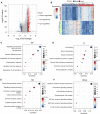Arachidonate lipoxygenases 5 is a novel prognostic biomarker and correlates with high tumor immune infiltration in low-grade glioma
- PMID: 36777735
- PMCID: PMC9911666
- DOI: 10.3389/fgene.2023.1027690
Arachidonate lipoxygenases 5 is a novel prognostic biomarker and correlates with high tumor immune infiltration in low-grade glioma
Abstract
Objective: To investigate the prognostic value of arachidonate lipoxygenases 5 (ALOX5) expression and methylation, and explore the immune functions of arachidonate lipoxygenases 5 expression in low-grade glioma (LGG). Materials and Methods: Using efficient bioinformatics approaches, the differential expression of arachidonate lipoxygenases 5 and the association of its expression with clinicopathological characteristics were evaluated. Then, we analyzed the prognostic significance of arachidonate lipoxygenases 5 expression and its methylation level followed by immune cell infiltration analysis. The functional enrichment analysis was conducted to determine the possible regulatory pathways of arachidonate lipoxygenases 5 in low-grade glioma. Finally, the drug sensitivity analysis was performed to explore the correlation between arachidonate lipoxygenases 5 expression and chemotherapeutic drugs. Results: arachidonate lipoxygenases 5 mRNA expression was increased in low-grade glioma and its expression had a notable relation with age and subtype (p < 0.05). The elevated mRNA level of arachidonate lipoxygenases 5 could independently predict the disease-specific survival (DSS), overall survival (OS), and progression-free interval (PFI) (p < 0.05). Besides, arachidonate lipoxygenases 5 expression was negatively correlated with its methylation level and the arachidonate lipoxygenases 5 hypomethylation led to a worse prognosis (p < 0.05). The arachidonate lipoxygenases 5 expression also showed a positive connection with immune cells, while low-grade glioma patients with higher immune cell infiltration had poor survival probability (p < 0.05). Further, arachidonate lipoxygenases 5 might be involved in immune- and inflammation-related pathways. Importantly, arachidonate lipoxygenases 5 expression was negatively related to drug sensitivity. Conclusion: arachidonate lipoxygenases 5 might be a promising biomarker, and it probably occupies a vital role in immune cell infiltration in low-grade glioma.
Keywords: arachidonate lipoxygenases 5 expression; immune cell infiltration; low-grade glioma; methylation; prognosis.
Copyright © 2023 Pan, Zhang, Chen and Liu.
Conflict of interest statement
The authors declare that the research was conducted in the absence of any commercial or financial relationships that could be construed as a potential conflict of interest.
Figures













Similar articles
-
Abundant expression of ferroptosis-related SAT1 is related to unfavorable outcome and immune cell infiltration in low-grade glioma.BMC Cancer. 2022 Feb 28;22(1):215. doi: 10.1186/s12885-022-09313-w. BMC Cancer. 2022. PMID: 35227235 Free PMC article.
-
Next-generation sequencing identifies HOXA6 as a novel oncogenic gene in low grade glioma.Aging (Albany NY). 2022 Mar 29;14(6):2819-2854. doi: 10.18632/aging.203977. Epub 2022 Mar 29. Aging (Albany NY). 2022. PMID: 35349479 Free PMC article.
-
Elevated TYROBP expression predicts poor prognosis and high tumor immune infiltration in patients with low-grade glioma.BMC Cancer. 2021 Jun 23;21(1):723. doi: 10.1186/s12885-021-08456-6. BMC Cancer. 2021. PMID: 34162355 Free PMC article.
-
EFNA1 is a potential key gene that correlates with immune infiltration in low-grade glioma.Medicine (Baltimore). 2021 Jun 4;100(22):e26188. doi: 10.1097/MD.0000000000026188. Medicine (Baltimore). 2021. PMID: 34087884 Free PMC article.
-
PTPRN Serves as a Prognostic Biomarker and Correlated with Immune Infiltrates in Low Grade Glioma.Brain Sci. 2022 Jun 10;12(6):763. doi: 10.3390/brainsci12060763. Brain Sci. 2022. PMID: 35741647 Free PMC article.
Cited by
-
TTK is a potential regulator of tumor progression correlated with dedifferentiation and immune cell infiltration in papillary thyroid cancer.Aging (Albany NY). 2023 Oct 6;15(19):10607-10626. doi: 10.18632/aging.205100. Epub 2023 Oct 6. Aging (Albany NY). 2023. PMID: 37815894 Free PMC article.
-
NF-κB in the Radiation Response of A549 Non-Small Cell Lung Cancer Cells to X-rays and Carbon Ions under Hypoxia.Int J Mol Sci. 2024 Apr 19;25(8):4495. doi: 10.3390/ijms25084495. Int J Mol Sci. 2024. PMID: 38674080 Free PMC article.
-
Immune cell infiltration and inflammatory landscape in primary brain tumours.J Transl Med. 2024 May 30;22(1):521. doi: 10.1186/s12967-024-05309-1. J Transl Med. 2024. PMID: 38816839 Free PMC article.
-
ALOX5 contributes to glioma progression by promoting 5-HETE-mediated immunosuppressive M2 polarization and PD-L1 expression of glioma-associated microglia/macrophages.J Immunother Cancer. 2024 Aug 13;12(8):e009492. doi: 10.1136/jitc-2024-009492. J Immunother Cancer. 2024. PMID: 39142719 Free PMC article.
References
LinkOut - more resources
Full Text Sources

